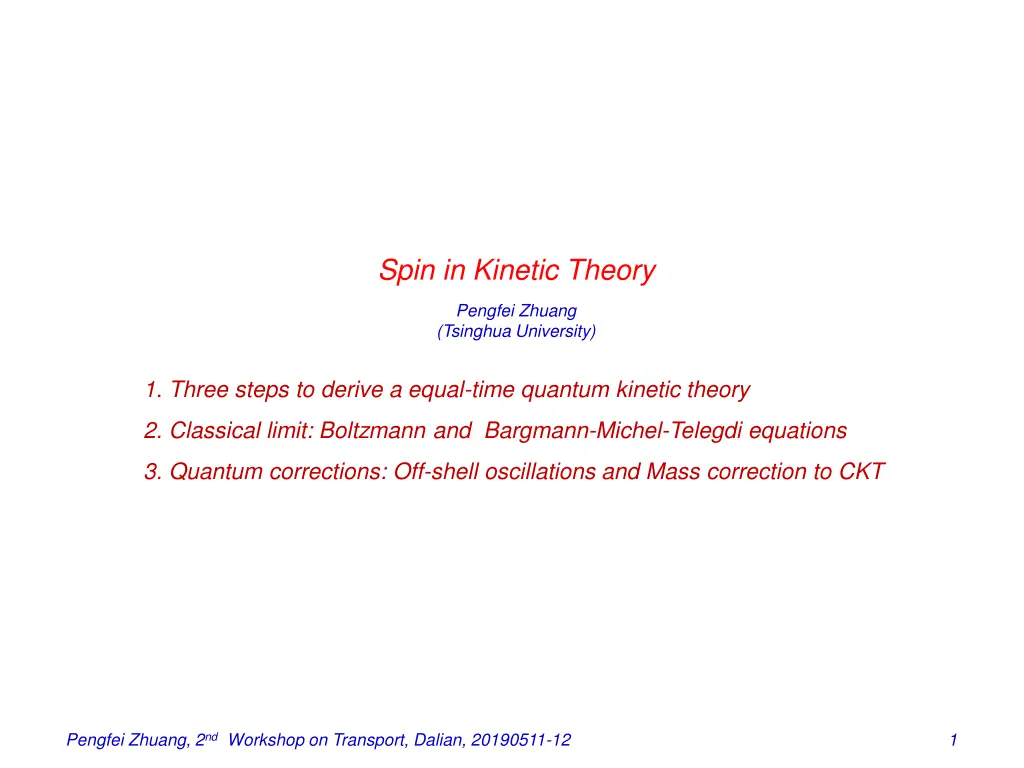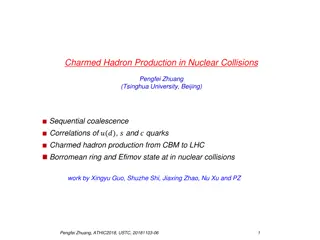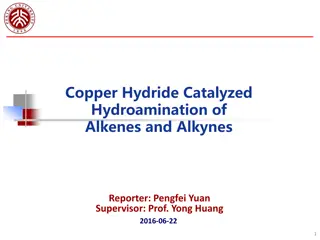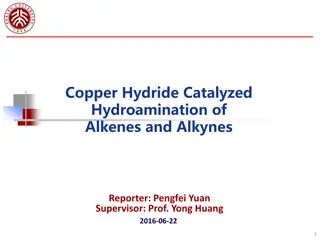
Quantum Kinetic Theory with Equal-Time Formalism and Spin
Explore the derivation of a quantum kinetic theory incorporating spin effects, covering topics such as classical and quantum multi-particle systems, covariant Wigner functions, and the construction of equal-time kinetic equations for quantum electrodynamics and quantum chromodynamics. Discover the significance of spin in relativistic and quantum physics studies, from condensed matter to high-energy nuclear collisions.
Uploaded on | 1 Views
Download Presentation

Please find below an Image/Link to download the presentation.
The content on the website is provided AS IS for your information and personal use only. It may not be sold, licensed, or shared on other websites without obtaining consent from the author. If you encounter any issues during the download, it is possible that the publisher has removed the file from their server.
You are allowed to download the files provided on this website for personal or commercial use, subject to the condition that they are used lawfully. All files are the property of their respective owners.
The content on the website is provided AS IS for your information and personal use only. It may not be sold, licensed, or shared on other websites without obtaining consent from the author.
E N D
Presentation Transcript
Spin in Kinetic Theory Pengfei Zhuang (Tsinghua University) 1. Three steps to derive a equal-time quantum kinetic theory 2. Classical limit: Boltzmann and Bargmann-Michel-Telegdi equations 3. Quantum corrections: Off-shell oscillations and Mass correction to CKT Pengfei Zhuang, 2ndWorkshop on Transport, Dalian, 20190511-12 1
Spin is a relativistic and quantum effect Spin, introduced through Dirac equation, is almost the most hot topic in recent physics study, including condensed matter, cold atoms, and nuclear physics. Classical multi-particle systems: Classical kinetic theory for particle number distribution ?(?,?): ????+1 2???2?? ?2 ?2? ?,? = 0. ? ? ?,? = ???????? ???? Many successful transport codes like AMPT, BAMPS and UrQMD in HIC. Quantum multi-particle systems: Quantum kinetic theory for particle number distribution ?(?,?) and spin distribution ?(?,?). Recent quantum effects like CME and CVE in HIC. Question: How to set up a relativistic and quantum kinetic theory including spin? Pengfei Zhuang, 2ndWorkshop on Transport, Dalian, 20190511-12 2
Covariant and equal-time Wigner functions Covariant Wigner function, a direct extension of the probability function ??+in QM 1 2?? ? ?+?? ? ?(? ? ?? ? ?,? = ?4????? ?(? +? 1 2)? 2) 2 Covariant kinetic theory for QED: D.Vasak, M.Gyulassy and H.Elze, Ann.Phys.173, 462(1987) Covariant kinetic theory for QGP: H.Elze and U.Heinz, Phys. Rept. 183, 81(1989) Recent study on CME: M.Stephanov and Y.Yin, PRL109, 162001 (2012) D.Son and N.Yamamoto. PRD87, 085016(2013) J.Chen, S.Pu, Q.Wang and X.Wang, PRL110, 262301(2013) Y.Hidaka, S.Pu and D.Yang. PRD95, 091901(2017) A.Huang, Y.Jiang, S.Shi, J.Liao and PZ, 2018, Advantage: The kinetic equations, obtained from Dirac and Maxwell equations, are covariant. Disadvantage: ?(?,?) at a fixed time ?0is related to ? and ? at all times ( ??0, ??), but the physics distributions are defined in equal-time space ? ?, ?;? . Conclusion: We should go to the equal-time formalism. Equal-time Wigner function in gauge field ?(?) 1 2?? ? ?+??;? ? ?+( ? ? ?? ? ?, ?;? = ?3 ?? ? ? ? ?( ? + ? 1 2;?)? 2;?) = ??0?(?,?)?0 2 Equal-time kinetic theory for QED: I.Bialynicki-Birula, P.Gornicki and J.Rafelski (BGR), PRD44, 1825(1991) PZ and U.Heinz, 1996, 1998 Recent study on ??1 , magnetic moment and CME: X.Guo and PZ, 2018 S.Mao and D.Rischke, Phys. Lett. B792, 149(2019) Z.Wang, X.Guo, S.Shi and PZ, 2019, Note: ?( ?, ?;?) is not equivalent to ?(?,?), only the complete set ?? ?, ?;? = ??0?0 (? = 0,1,2, ) is equivalent to ?(?,?) ! ?? ?,? ?0 Pengfei Zhuang, 2ndWorkshop on Transport, Dalian, 20190511-12 3
We take NJL as an example to show the 3 steps to construct an equal-time kinetic theory For general discussion, see PZ and U.Heinz, 1998 1ststep: Covariant kinetic theory Consider quarks in external electromagnetic fields. 1 2??? ?+?? ? ?? ?(? +? 2) ?(? ? 1 ? ?,? = ?4?????? 2) 2 NJL model: = ? ????? ?0? + ? ??2+ spontaneous chiral symmetry breaking: ???5 ??2, ??= ??+ ????, ? = ???? ??,?? ? ? = 2? ?? Dirac equation at mean field level: ????? ? ? = 0, ? = ?0 ? Covariant kinetic equations: ?(?,?) ?? (?,?) ???? ? ? ?,? = ? 2???? ? with electromagnetic operator ??and chiral operator ?: ??= ?+? 1/2??????(? ? ???)?? ? = ?1+ ??2 ?1= ?0 cos( 2?? 1/2?????(? ? ???)?? ?, ??= ?? ? 1/2 ? ?= ?? ?? 1/2 2????)?(?), ?2= sin( 2????)?(?), Pengfei Zhuang, 2ndWorkshop on Transport, Dalian, 20190511-12 4
2ndstep: Equal-time hierarchy Covariant transport and constraint equations: ?+= ?0??0 ????+ ??+ ? + ?+?(?,?) = 0, ???? ??+ ? ?+?(?,?) = ? ???? ???????? ??, ?????????? ???????? ? ?? ? , ???????? ??, ????????? ???????? ?0-integrating the covariant equations: ????????? ????????? ??? ?( ?, ?;?) ?????????? ???????? ??? ?1( ?, ?;?) ?0-integrating ?0 (covariant equations): ????????? ????????? ??? ?1( ?, ?;?) ?????????? ???????? ??? ?2( ?, ?;?) Spin decomposition: ? ?,? =1 ? ?, ?;? =1 16 transport and 16 constraint equations 4? + ??5? + ????+ ?5????+1 2?????? 4?0+ ?5?1 ??0?5?2+ ?0?3+ ?5?0 ? ?0+ ?0 ? ?1 ? ? ?2 ?5 ? ?3 Chiral condensate is coupled to Wigner function ? ? = ? ?3 ??3( ?, ?;?) Pengfei Zhuang, 2ndWorkshop on Transport, Dalian, 20190511-12 5
3rdstep: Truncating the hierarchy Semi-classically expanding the 16 + 16 equations: ? ?,? = ?0?,? + ?1?,? + ? ?, ?;? = ?(0) ?, ?;? + ?(1) ?, ?;? + ??= ?? ? = ?(0)+ ?(1)+ (0)+ ?? (1)+ Constraint equations to the zeroth order in (classical limit): 1) on-shell condition: ?? 2= ?2+ ?2 (0)and ?0 (0)= 0, ?3 (0) 2) only 2 independent components: ?0 ?1 ? ?? ?0 ? ???0 2?0 (0)= (0), ?2 (0)= (0) (0) ? ?0 ??? (0) (0) ? ?? ? ?0 ? ???0 (0)= (0), ?2 (0)= (0)= , ?3 ?1 ? 3) gap equation: (0)( ?, ?;?) ?? ?3 ? 2?3 ?0 ?0 ?(?) 1 + 2? ?0= 0 Physics of the components: ?0 ?1 ?1 (0): ?????? ???????, ?0 (0): ??????? ??????? , ?2 (0): ?????? ???????, ?3 (0): ???? ??????? (0): ????????? ? ???? ???????, ?3 (0): ???????? ?????? (0): ???? ??????? Pengfei Zhuang, 2ndWorkshop on Transport, Dalian, 20190511-12 6
Classical transport equations Transport equations to the first order in : Vlasov equation for number density ?0 (0): ? ?? ? ?0 1 (0) (0)= 0 ??2 ???0 ??+ 2?? (0): Bargmann-Michel-Telegdi equation for spin density ?0 ? ?? ? 1 ? ?? (0) (0)= (0) (0) ??2 ?? ?0 ??+ ?0 2 ? ? ?0 ??? ?0 2?? ??= ??+ ?? ??, ? = ? + ?? ?? the effective collision terms on the right hand side is due to the quark spin interaction with the electromagnetic fields. (0)and ?0 (0). There is no coupling between ?0 A homogeneous solution 2 ? ? ?2?2 (0)= ?0 ? ?? ? ? (0)= ?0 ?2? + Pengfei Zhuang, 2ndWorkshop on Transport, Dalian, 20190511-12 7
Quantum off-shell effect Constraint equations to the first order in : ??0?0?(1) 1 (1) ? ?1 ??0?0?0 ??0?0?0? ??0?0?(1) 1 ??0?0?(1) 1 ??0?0 ?(1) 1 (1) 0= ??0 1= ??3 1= 0 0= 0 2? ?2 2? ?3 2? ?0 2? ?1 (1)= 0 1 0 ??0 0 ??1 (1)= ? ?0 ??0?0?0 (1) ? ?0 (1) ??+1 (1)= ? ?3 (1) (1)= 0 (1)???? ?? ? ?2 (1) 0+ ? ?3 2??3 ??0?0??? Shell shift from ? ?0 ?? to ? ?0 (??+ ???) ? There is no solution of a definite shell shift ???! From on-shell to off-shell ? ?0 ?? ? ?0 ?? ?(?) ? ? :? ?????????? ???????? ?? ?0 The off-shell terms ??= ??0?0?0(?,?)?(?) is determined by the constraint equations: (0) (0) ? ?0 2??, ???1 = ? ? ? ?0 2? (0), ???0 = 2?0 ???2 = 2?? 0 0 0 ? ? ?0 2??? ? ? ? ?0 2??? ? ?0 ? ? ? (0) , ?? ?0 = ???3 = 2?+ 2 ? ?0 2 2?? 2?? 0 (0) ? ? ?0 2?? ? ?0 2?? ?? ?? (0), (0) , ?? ?2 = ?? ?1 = 2?0 ?? ?3 = 2?0 2 2?? 2?? Pengfei Zhuang, 2ndWorkshop on Transport, Dalian, 20190511-12 8
Quantum transport equations Transport equations to the second order in : Vlasov equation for number density ?0 (1): 0 ? ? ? ?0 ?? ? ?? ? ?0 ? ? (1)= 0 0+ ??+ 2 ? ?0 3 ? ? ?0 4 2?? 2?? (1): Bargmann-Michel-Telegdi equation for spin density ?0 ? ?? ? 3+? ? ? ?? ? ? ? (1)= (1) (1) (0) ??+ ?0 2 ? ? ?0 ??? ?0 ? ??0 4 2?? 2?? ? ? 5 ? ? ? (0) + ?0 4 ?? 2?? Mass correction to CKE Introduce chiral components ??= ?0+ ??1, ? = For small quark mass, constant magnetic field, and to the first order in , ????+ ? ???+ ? ????= ? 0 ?? ?0 Conclusion: mass correction to CME is linear in and therefore should be small. Pengfei Zhuang, 2ndWorkshop on Transport, Dalian, 20190511-12 9
Off-shell oscillations The solution of the full transport equations for a homogeneous system: ???0= 0 ???1+ 2??2 2??3= 0 ???2+ 2 ? ?3 2??1= 0 ???3 2 ? ?2+ 2??1= 0 ?? ?0= 0 ?? ?1+ 2? ?2 2? ?3= 0 ?? ?2+ 2 ??3 2? ?1= 0 ?? ?3 2 ??2+ 2? ?1= 0 Conclusion: Off-shell effect multi-component coupling memory effect strong oscillations. Pengfei Zhuang, 2ndWorkshop on Transport, Dalian, 20190511-12 10
Always equivalent ? One must go from covariant to equal-time formalism. ?? ?,? , ? = 0,1,2, is equivalent to ?(?,?). ?? ?, ?;? = ??0?0 In on-shell case, ?? ?,? ? ?0 ?? = ?? ??( ?, ?;?), ?? ?, ?;? = ??0?0 ?( ?, ?;?) is equivalent to ?(?,?). There are two ways to do semi-classical expansion: 1) -expansion first and then ?0-integration (Wang, Hidaka, ), and 2) ?0-integration first and then -expansion (Zhuang, Heinz, ). At a general order ? ?, ?( ?, ?;?) and ?(?,?) are not equivalent to each other, because the -expansion in the first way is done in 4D momentum space, but the expansion in the second way is in 3D momentum space, and the quantum effect along ?0-direction is already integrated. Pengfei Zhuang, 2ndWorkshop on Transport, Dalian, 20190511-12 11
Summary 1) To have physics distributions, we should go from covariant to equal-time formalism. The question is how to set up a complete equal-time theory. In general case, the full set ?? ?, ?;? = ??0?0 equivalent to ?(?,?). Only in on-shell case, ? ?, ?;? itself is equivalent to ? ?,? . ?? ?,? , ? = 0,1,2, is 2) In a strong electromagnetic field, spin is the first order quantum correction to the classical Boltzmann transport, it leads to CME, CVE and other chiral anomaly effects. 3) For off-shell particles, the multi-component coupling leads to a strong memory effect and in turn a strong oscillation. Pengfei Zhuang, 2ndWorkshop on Transport, Dalian, 20190511-12 12



